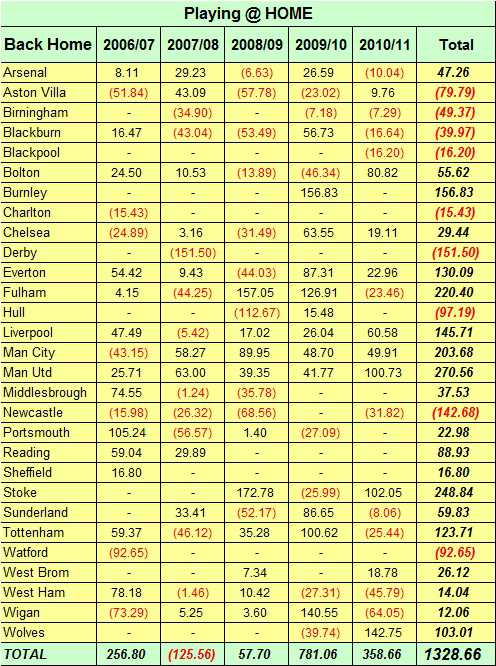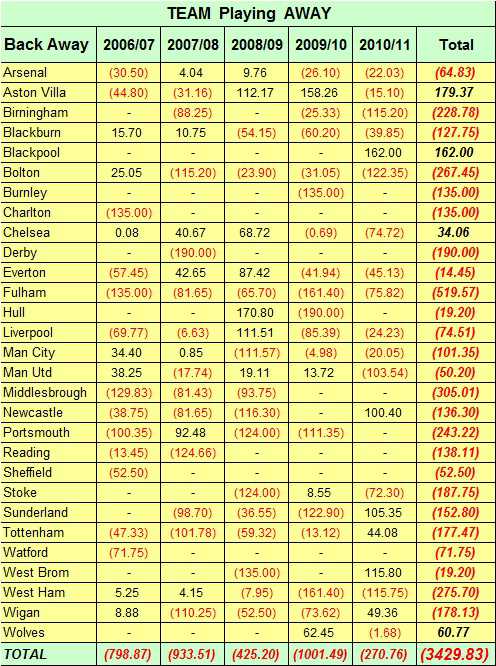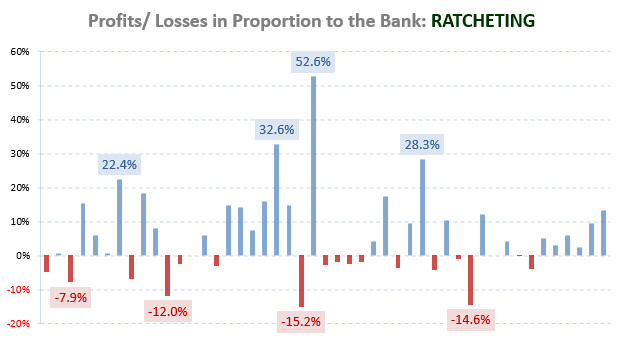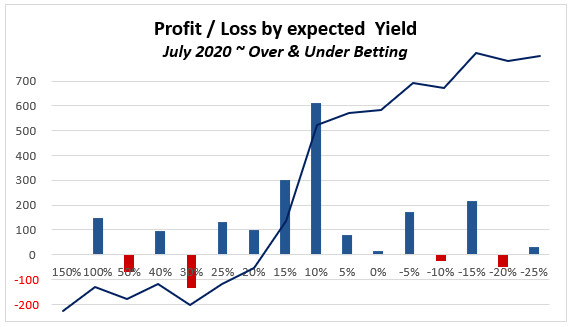
The Numbers Game
Between 2006-2011, if you had gambled unemotionally and systematically on all English Premier League matches to be home wins and placed a constant stake of 10 € per fixture, then at the end of the fifth season, your winnings would have totalled 1,328.66 €.
That’s equivalent to an interest rate of 6.99% on the capital expended (turnover: 1,900 bets @ 10 € each = 19,000 €; 1,328.66 € is 6.99% of 19,000 €), more than double the rate of the best savings account currently on offer in the UK (times have changed since!).
The table below summarises the home record of every team involved in the Premier League during seasons 2006-2011, and shows the end totals from a constant staking plan of 10 units per match:

To reiterate, a bet of 10 units placed on each of the 380 ‘home’ games in a Premier League season, with no omissions, would have resulted in a handsome profit over the five seasons analysed, no matter how the results predicted beforehand (i.e. the odds) were perceived.
It places no reliance upon team news, injuries, form of the teams involved, or any other extraneous factor surrounding the games in question. It’s a quick and easy method to follow just so long as you can guarantee being able to bet on every match for five entire seasons, a total of 1,900 bets (assuming no matches are abandoned and/or replayed).
On the other side of the coin, if you followed the same strategy backing the ‘away’ teams to win every game, then 3,428.83 € would have been lost!

Some illustrations from the two tables: If you chose to refine your strategy and bet only on Tottenham to win every match at home, using a fixed stake of 10 € would have yielded profits of 123.71 € over five years.
However, a strategy of backing Tottenham to win every match away from home would have resulted in a loss of 177.47 €. In the same period, Fulham would have brought a profit of 220.40 € to win every home game, but a loss of 519.57 € backing them away from home.
These tables suggest that it is unwise to bet on any team in the English Premier League to win away from home on a consistent basis.
This is due to a combination of unpredictability in this league where ‘upsets’ happen on a regular basis, and the fact that the odds set by bookmakers and betting exchanges for these games seem not to afford the opportunity of long-term profits (value) for the bettor.
All of the tabular calculations have been based on ‘real’ odds exactly as they were found in the market (Ladbrokes). The losses in the above table indicate that the odds offered for away wins seem to be constantly too short or under-priced considering that on average, only 25% of matches in the English Premier League finish in victories for the away team.
 Image: Symbiot (Shutterstock)
Image: Symbiot (Shutterstock)At this stage we do not have a concrete explanation for this obvious discrepancy in the bookmaker/market odds calculations between home and away prices. The only reason we venture to suggest is that away match prices are perhaps a good mechanism for bookmakers to achieve some form of guaranteed income?
Before beginning this evaluation, our theory was that the results would be relatively balanced between betting on home, draw or away results and that the bettor should theoretically break-even (i.e. the bookmakers wouldn’t allow a significant profit margin to be made from any of these markets).








Hi,
You have a real nice yield!
I assume the “system” works in long term due to the fact that you probably contribute to balance the bookie and keeping each bet relativly small, so you will not affect the market or the bookie to much?
I order to spread your risk you need to play a pretty large and diversified portfolio. You also never use your whole bank in one betting round. This automatically reduces the amounts for each bet to relatively small stakes.
For example, you have a bank of 20,000 units, and you risk 20% per betting round –> meaning you are risking 4,000 units. Your betting portfolio consists of around 100 bets, which translates to a risk of 40 units per bet. These kind of amounts certainly do not affect the market.
However, to be honest. Income from betting is a very slow process. There are seldom more than 3 betting rounds a months = 4,000 x 3 = 12,000 turnover. If you are lucky you’ll achieve a 10% Yield on average, meaning 1,200 units per month. But there will be months which produce a deficit, so you have to look at the whole year.
There is an article and also course in preparation on this topic. Just keep checking. We will also certainly email the news when it’s available to everybody.
Hi,i want to follow your strategy,aston villa home,everton away,fulham away.i saw that you gathered the results from the last 5 seasons 2006 to 2011.so if i want to find teams that make draws away or at home that produce profit,i need to check the last 5 seasons?thanks
I forgot to mention:back draw when villa plays home,back draw when everton plays away,back draw when fulham plays away.
Hi, I have been reading your website in an effort to teach myself about probability and I am really enjoying the insights you present, so thank you very much! To be honest, I really had no idea home games were so heavily weighted towards the home team, I had always assumed it was only a 33% chance with the 3 possible outcomes, but with all the data I have looked at so far you are spot on – it is around 45%. To test what I have learnt I just did a quick model of historic data from the 2013-14 EPL season and if you betted $1 on every home team to win ($380), with Ladbrokes returns you would be up 96c at the end of the season. Does that sound about right to you?
Hi Sprocket,
Yes, this sounds about right and highlights the fact that you must always seek to place bets at the highest odds you can find.
If you are still into experimenting why not have a look at the underdog to win at half-time – some very surprising results in that market – especially the away underdog performs extremely profitably in most leagues, although you’ll need to factor in the winning and losing streaks to get a real focus on this market and to calculate a suitable progressive staking plan.
Backing favourites in any market is always a recipe for disaster as they are invariably underpriced, meaning long-term losses in most leagues you can analyse.
But is assuming 10% on top of Ladbrokes odds not way too much? F.e. if home has an odd of 1.70, no other bookie will have odds of 1.87. So this is definitely a game changer.
Hi Sander,
Ladbrokes is a middle of the road bookmaker and we were attempting to simulate betting exchange odds hence the 10% mark-up on Ladbrokes’ odds (see picture captions).
Hope this helps.
If it’s guaranteed, why not increase the bank to maximise profit ie £2000 bank, £400 stake a game?
Hi Ethan,
Succesfull betting is not about maximising profits but about managing risk. You may find this article useful: The Science of Calculating Winning and Losing Streaks
Hello Soccerwidow!
I would like to ask that if I calulcate the percentage of draws in 5 seasons of data and for example it’s average is 27, with a standard deviation of 3 % , I have to calculate the average odds for theese events to know that if this is profitable or not?
for example:
24 to 30 % draws percentage
bookmakers are offered for theese events an average of 2,85 odds (35%)
This means that betting always on draws, can bring us profit?
Thanks
Hi sarkec, this isn’t a question which is a straight forward answer. Sorry!
If you wish to work out a Back or Lay the Draw strategy you will need to get a few HDAFU table. There you will find inflection point graphs which help to identify the odds clusters which are long-term profitable.
Is there a formula to place bet on all three option and win (whatever happens) Home – Draw – Away
Hi Adam,
if you are referring to arbing/dutching, here’s an article on that topic: Dutching – Ausnutzen von Underround (Backen) & Overround (Layen)
Unfortunately, it’s in German only, so you will have to use Google.Translate to understand it. Sorry! However, I tried hard to write in short sentences so that an automated translation is still understandable.
Have fun! 🙂